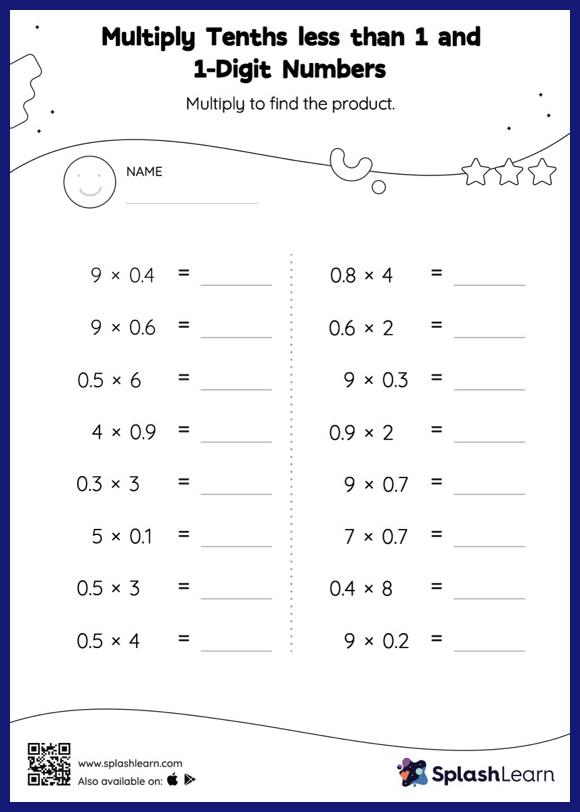How To Multiply Decimals And Whole Numbers

When it comes to mathematics, multiplication serves as one of the foundational operations that helps us solve complex problems across various fields. Among the various forms of numbers we encounter, whole numbers and decimals are particularly common. Understanding how to multiply decimals and whole numbers is essential for students, professionals, and anyone looking to enhance their mathematical skills. This guide will walk you through the process of multiplying these two types of numbers in a clear and straightforward manner.
Multiplying decimals and whole numbers can seem daunting at first, but once you grasp the steps involved, you'll find it becomes second nature. Whether you're working on a homework assignment, calculating expenses, or trying to understand a scientific formula, mastering this skill will empower you to handle numerical data more effectively. In this article, we will break down the multiplication process and provide helpful tips to ensure your calculations are accurate.
As we delve into the world of decimals and whole numbers, it's crucial to approach the topic with a positive mindset. Remember, practice makes perfect! By the end of this article, you'll have a comprehensive understanding of how to multiply decimals and whole numbers, enabling you to tackle various mathematical challenges with confidence.
What Are Whole Numbers and Decimals?
Before we dive into the multiplication process, let's clarify what whole numbers and decimals are:
- Whole Numbers: These are the set of numbers that include zero and all positive integers (1, 2, 3, ...). Whole numbers do not include fractions or decimals.
- Decimals: Decimals represent fractions in a different form and can be understood as a part of a whole. For example, 0.5 represents one-half, while 2.75 represents two whole units and three-quarters of another unit.
How to Multiply Decimals and Whole Numbers?
Now that we understand the basic definitions, let's explore the process of multiplying decimals and whole numbers step by step.
Step 1: Ignore the Decimal Point
When multiplying a decimal by a whole number, start by temporarily ignoring the decimal point in the decimal number. For example, if you're multiplying 2.5 by 4, treat it as 25 x 4.
Step 2: Perform the Multiplication
Next, multiply the whole number by the integer you created from the decimal. Using our example, 25 x 4 equals 100.
Step 3: Count the Decimal Places
After performing the multiplication, count how many decimal places were in the original decimal number. In our example, 2.5 has one decimal place.
Step 4: Place the Decimal Point
Finally, take the product from Step 2 and place the decimal point in the result according to the number of decimal places you counted in Step 3. Thus, we take 100 and place the decimal point one space to the left, giving us the final answer of 10.0 or simply 10.
What Are Common Mistakes When Multiplying Decimals and Whole Numbers?
Even experienced individuals can make mistakes while multiplying decimals and whole numbers. Here are some common pitfalls to avoid:
- Forgetting to Count Decimal Places: Always remember to count decimal places before placing the decimal point in the final answer.
- Misplacing the Decimal Point: Double-check your placement of the decimal point to avoid errors in the final result.
- Rounding Too Early: Avoid rounding the decimal until you've completed all calculations to maintain accuracy.
How Can Practice Improve Your Skills in Multiplying Decimals and Whole Numbers?
Like any skill, practice is paramount in mastering multiplication of decimals and whole numbers. Here are some effective strategies to enhance your skills:
- Use Worksheets: Find worksheets specifically designed for multiplying decimals and whole numbers to practice regularly.
- Online Resources: Utilize educational websites that provide interactive exercises and quizzes to reinforce your learning.
- Study in Groups: Collaborate with peers to solve problems together and explain concepts to one another.
- Real-Life Applications: Look for opportunities in daily life where you can apply multiplication, such as budgeting or shopping.
What Are Some Real-Life Applications of Multiplying Decimals and Whole Numbers?
Multiplying decimals and whole numbers is not just an academic exercise; it has several practical applications. Here are a few examples:
- Shopping: When calculating the total cost of items, you often multiply the price (a decimal) by the quantity (a whole number).
- Cooking: Recipes that require scaling ingredients often involve multiplying decimals to ensure the right proportions.
- Finance: Understanding interest rates and loan payments often requires multiplying decimals to determine amounts owed or earned.
How to Teach Others to Multiply Decimals and Whole Numbers?
If you're looking to teach someone else this essential skill, consider the following tips:
- Start with Basics: Ensure that they understand whole numbers and decimals before introducing multiplication.
- Use Visual Aids: Utilize diagrams or physical objects to illustrate the concept of multiplication.
- Provide Examples: Walk them through various examples and encourage them to solve similar problems independently.
- Be Patient: Everyone learns at their own pace, so be patient and supportive throughout the learning process.
Conclusion: Mastering How to Multiply Decimals and Whole Numbers
In conclusion, understanding how to multiply decimals and whole numbers is a vital skill in math that can be applied in various real-life situations. By following the outlined steps, avoiding common mistakes, and practicing regularly, you'll become proficient in this essential operation. Remember, practice makes perfect, so don’t hesitate to seek out opportunities to apply what you’ve learned. With diligence and effort, you'll master the art of multiplication and enhance your mathematical prowess!
You Also Like
Exploring The Life And Legacy Of Mai PhamDiscovering Greenland Capital: A Unique Perspective On Wealth And Opportunity
Minecraft Command To Stop Ticks: Mastering Game Performance
Discover The Elegance Of Black French Tip Nails
Unraveling The Dynamic Duo: Jason And Travis Kelce
Article Recommendations
ncG1vNJzZmiZlKK2r3rBqKmdnaKhrq%2Bw0mespGaTpLpwwNGynJygn2d8qbvWZquoZZ2qubW1z6WwZpyVmLaurcusZJqmlGLEqbvLnmSnrZ2XsrO%2FjaGrpqQ%3D